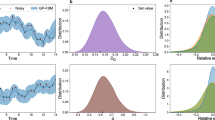Synopsis
A stochastic model of Feulgen hydrolysis is proposed. The model, constructed so as to embody the main features of chromatin structure, is simple enough to allow the calculation of extraction rates. Extraction rate curves generated by the model are compared with experimental curves obtained under various conditions (different fixatives and hydrolysis solutions). A good correspondence is found between the experiments and the predictions of the model.
Similar content being viewed by others
References
Andersson, G. K. A. &Agrell, I. P. S. (1972). Cytoplasmic and nuclear growth during the proliferation of Ehrlich ascites tumour cells in mice.Virchows Arch. Abt. B Zellpath. 11, 1–10.
Andersson, G. K. A. &Kjellstrand, P. T. T. (1971). Exposure and removal of stainable groups during Feulgen acid hydrolysis of fixed chromatine at different temperatures.Histochemie 27, 165–72.
Andersson, G. K. A. &Kjellstrand, P. T. T. (1972). Influence of acid concentration and temperature on fixed chromatine during Feulgen hydrolysis.Histochemie 30, 108–14.
Andersson, G. K. A. &Kjellstrand, P. T. T. (1975). A study of DNA depolymerisation during Feulgen acid hydrolysis.Histochemistry 43, 123–30.
Bobrow, M. (1973). Acridine orange and the investigation of chromosomes banding.Cold Spring Harb. Symp. quant. Biol. 38, 435–40.
Bradbury, E. M., Crane-Robinson, C., Goldman, H., Rattle, H. W. E. &Stephens, R. M. (1967). Spectroscopic studies of the conformations of histones and protamine.J. molec. Biol. 20, 507–23.
Brody, Th. (1974). Histones in cytological preparations.Expl. Cell Res. 85, 255–63.
Brown, D. M. &Todd, A. R. (1955). Evidence on the nature of the chemical bonds in nucleic acids. In:The Nucleic Acids, Chemistry and Biology, Vol. 1 (eds E. Chargaff & J. N. Davidson), pp. 409–45. New York: Academic Press.
Chargaff, E. (1955). Isolation and composition of the deoxypentose nucleic acids and the corresponding nucleoproteins. In:The Nucleic Acids, Chemistry and Biology, Vol. 1 (eds E. Chargaff & J. N. Davidson), pp. 307–71. New York: Academic Press.
Clark, R. J. &Felsenfeld, G. (1971). Structure of chromatin.Nature New Biol.,229, 101–6.
Clark, R. J. &Felsenfeld, G. (1974). Chemical probes of chromatin structure.Biochemistry 13, 3622–8.
Cleaver, J. E. &Boyer, H. W. (1972). Solubility and dialysis limits of DNA oligonucleotides.Biochim. biophys. Acta 262, 116–24.
Comings, D. E. (1972). The structure and function of chromatin.Adv. Hum. Genet. 3, 237–431.
Elgin, S. C. R. &Weintraub, H. (1975). Chromosomal proteins and chromatin structure.Ann. Rev. Biochem. 44, 725–74.
Itzhaki, R. F. (1970). Structure of Deoxyribonucleoprotein as revealed by its binding to polylysine.Biochem. biophys. Res. Commun. 41, 25–32.
Kjellstrand, P. T. T. &Andersson, G. K. A. (1975a). Histochemical properties of spermatozoa and somatic cells. I: Relations between the Feulgen hydrolysis pattern and the composition of the nucleoproteins.Histochem. J. 7, 563–73.
Kjellstrand, P. T. T. &Andersson, G. K. A. (1975b). Histochemical properties of spermatozoa and somatic cells. II: Differences in the Feulgen hydrolysis pattern induced through alterations of the nucleoprotein complex.Histochem. J. 7, 575–83.
Laurent, T. C. (1968). The exclusion of macromolecules from polysaccaride media. In:The Chemical Physiology of Mucopolysaccarides (ed. G. Quintarelli), pp. 153–68. Boston: Little, Brown.
Mackay, M., Hilgartner, C. A. &Dounce, A. L. (1968). Further studies of DNA-nucleoprotein gels and residual protein of isolated cell nuclei.Expl. Cell Res. 49, 533–57.
Mirsky, A. E. &Ris, H. (1951). The composition and structure of isolated chromosomes.J. Gen. Physiol. 34, 475–92.
Ogston, A. G., Oreston, B. N. &Wells, J. D. (1973). On the transport of compact particles through solutions of chain polymers.Proc. R. Soc. Lond. 333, 297–316.
Richards, B. M. &Pardon, J. F. (1970). The molecular structure of nucleohistone (DNH).Expl. Cell Res. 62, 184–96.
Ris, H. &Kubai, D. F. (1970). Chromosome structure.Ann. Rev. Genet. 4, 263–94.
Scott, J. E. (1974). The Feulgen reaction in polyvinyl alcohol or polyethylene glycol solution. ‘Fixation’ by excluded volume.J. Histochem. Cytochem. 22, 833–5.
Walker, I. O. (1965). Electrometric and spectrophotometric titration of histone and deoxyribonucleohistone.J. molec. Biol.,14, 381–98.
Watson, J. D. &Crick, F. H. C. (1953). A structure for deoxyridose nucleic acids.Nature (London) 171, 737–8.
Author information
Authors and Affiliations
Rights and permissions
About this article
Cite this article
Kjellstrand, P., Lamm, C.J. A model of the breakdown and removal of the chromatin components during Feulgen acid hydrolysis. Histochem J 8, 419–430 (1976). https://doi.org/10.1007/BF01003830
Received:
Revised:
Issue Date:
DOI: https://doi.org/10.1007/BF01003830




